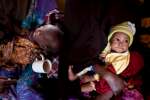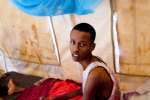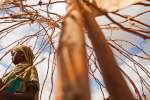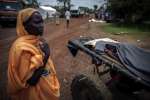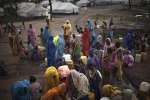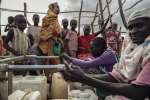UNHCR battles cholera at world's largest refugee complex
News Stories, 31 December 2015
DADAAB, Kenya, Dec 31 (UNHCR) – Health workers at the world's largest refugee complex in Kenya are gaining the upper hand in battling a cholera outbreak that has killed 10 people and sickened around 1,000 others since it broke out last month amid rains linked to El Niño.
Cholera, an often fatal water-borne bacterial illness, which causes fever, vomiting and watery diarrhoea, flared up in mid-November at Dadaab, which comprises five camps hosting 347,000 refugees and asylum seekers, the majority fleeing violence in Somalia.
An outbreak control team comprising staff from the UN Refugee Agency and partner agencies, has worked with the Kenyan Health Ministry and Department of Refugee Affairs officials around the clock to treat cases and stamp out the disease at the sprawling complex in North-Eastern Kenya.
Among patients brought to one of four cholera treatment centres set up at Dadaab was two-year-old Faisal, a refugee whose family fled Mogadishu, Somalia. The toddler tested positive for the illness and was admitted to the hospital, where his condition stabilized and improved after three days of treatment.
"We don't know what caused the cholera but thank God, he is better now … He got a lot of fluid here, I am happy," said Faisal's father, 32-year-old Ahmed, who seemed satisfied with the treatment his son received in the hospital.
The four specialized treatment centres, each of which can treat more than 50 patients, provide intravenous rehydration to those in the critical wards, who receive care around the clock from dedicated staff.
"They cannot take medicine orally, so we transfuse to hydrate and treat them. Once they are stable, they are moved out of the critical area. On average it takes three days for a patient to recover and discharge," said Caroline, a doctor in Hagadera camp hospital which is managed by the International Rescue Committee.
Officials said the flare up has been aggravated by pooling groundwater caused by El Niño rains – a cyclical warming of a Pacific Ocean current that causes anomalous weather patterns around the globe, ranging from unseasonal flooding to droughts.
Promoting hygiene is a pillar of the broader push to curb the outbreak at the complex. UNHCR and its partner agencies have been carrying out soap distribution, house and latrine disinfection and hygiene promotion campaign across all the five camps. Among those on teams disinfecting refugees' accommodation is Isaq Abdi, a 43-year-old refugee from Somalia.
"Spraying is going on well," said Abdi, who reckoned he had sprayed 200 latrines and 200 homes at the Ifo 2 camp as part of a Kenya Red Cross Society team. "People appreciate our work. I like what I do because I am helping my community, preventing diseases and also getting an allowance," he added.
UNHCR is also endeavouring to increase the number of latrines at the camp, although decreased funding in recent years has hindered the drive.
The first case of the current Cholera outbreak in Dadaab was reported on November 18 at the Ifo 2 camp: a 10-year-old boy who had been playing in a stagnant pool and may have swallowed some of the water. He has since been treated and recovered.
UNHCR continues to educate children, parents and community about the risk of swimming in muddy water ponds in and around the camps. Filling in such pools – wherever possible – has also been carried out. Local FM radio stations have frequently airing community sensitization messages.
The first camp, Hagadera, was established at Dadaab in 1991, when refugees fleeing the civil war in Somalia started to cross the border into Kenya. A second large influx occurred in 2011, when some 130,000 refugees arrived, fleeing drought and famine in southern Somalia.
By Assadullah Nasrullah in Dadaab, Kenya









